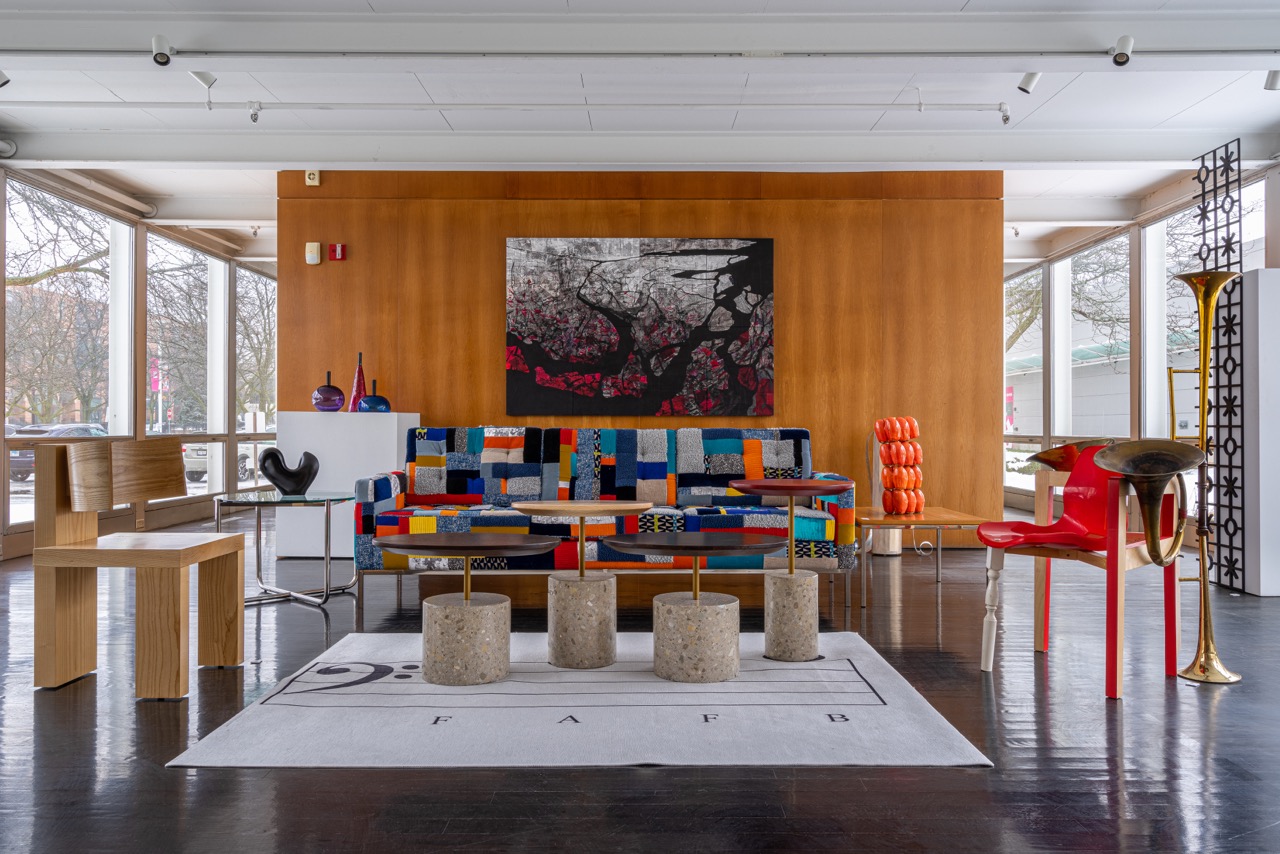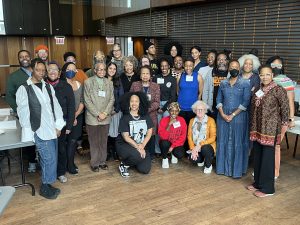There’s nothing quite like jazz. With influences from the blues, ragtime, classical, and more music, jazz is a uniquely American music style. But, most importantly, it’s a Black American art form. With its roots in the late 19th century New Orleans Black community, the genre has expanded across the country over the last century to encompass the Black experience. From Chicago to Harlem, from DC to Nashville, each city adds its regional spin making jazz a symphony of Black stories and experiences. John Coltrane was one of the most influential jazz artists of the 20th century. A saxophonist and composer, Coltrane’s work shaped the direction of jazz music for decades. Named after Coltrane’s iconic album, dual exhibitions A Love Supreme and A Love Supreme: McCormick House Reimagined, at Elmhurst Art Museum and McCormick House, bring art, design, and jazz come together for a show that charts the story of the album and its influences on artists and designers. Curators Norman Teague and Rose Camara combine three-dimensional art with themes Coltrane explored in his musical journey, specifically his deep reverence for spirituality and love. The result is a cool, contemporary exhibition driven by Black aesthetics and filled with fluid, funky contemporary art pieces that explore the past and reflect the black experience but are orientated very much toward the future.
Split across two spaces, the white-walled galleries of the Elmhurst Art Museum host the exhibition of Norman Teague’s art and design work while Mies van der Rohe’s McCormick House houses a group show featuring 35 BIPOC artists and designers. The museum portion of the show demonstrates the strongest thematic, spiritual connection to Coltrane’s album. Teague creates a dialogue between the art and the music by inviting the viewer to engage with Coltrane’s music simultaneously with the art. The four galleries are each titled after a song/movement on Coltrane’s album. The galleries, Part 1: “Acknowledgement”, Part 2: “Resolution”, Part 3: “Pursuance”, and Part 4: “Psalm”, are each accompanied by a QR code directly linked to their respective song. The storytelling flows from there. Listening to the music while viewing the show is an absolute must because the connection between them is seamless. Teague’s quirky pieces, whether made of wood, vinyl, or even cast from instruments, contain a musicality. At certain points in the music, Teague’s sculptures almost mimic the conversation between Coltrane’s saxophone and McCoy Tyner’s piano. The musical connection is most grandly displayed in the large wooden piece housed in the center gallery. Shaped like an African roundhouse, the work is stripped down to nothing more than a wood frame. Flexed reeds are pulled taut by strings, and each curved reed evokes the undulations of music. Coltrane’s second part, “Resolution” is exuberant and emotional. Paired with Teague’s sensual, smooth craftsmanship, the melody almost emanates from each item. It’s a heady, immersive experience. Exhibitions should be like this. Engaging and creative.
The famous Mies van der Rohe’s McCormick House hosts the latter portion of the show. With its gorgeous floor-to-ceiling windows and warm wood paneling, it’s like entering the living room of the casually cool, sexy, laid-back, jazz aficionado. Fittingly, jazz flits through the small modernist space, amplifying the vibe. The aesthetics of jazz and African influence are woven through the exhibition. Oluwaseyi Adeleke’s photograph of a woman balancing a tray of glass bottles on her head as she makes her way down the street. Shani Crowe’s striking black-and-white photograph. The unclothed shoulders of a dark-skinned model. Their jet-black hair is done in a series of elaborate African-style braids that twist and loop and is adorned with a cowrie shell that hangs to the center of the sitter’s back. Installed over the Florence Knoll-designed couch reupholstered by Norman Teague, Roland Knowlden’s wood-paneled artwork is a fitting centerpiece. The black-white-and-red deconstructed map conveys a sense of urban tumult that speaks directly to the experience of Black city dwellers, the type of communities where early jazz proliferated. The curators and the 35 contributing artists eschew the standard “white cube” gallery for something more inviting and cool. It evokes the past, present, and future—the infinite of Blackness.
Whether you are familiar with Coltrane’s body of work or not, the exhibition is enjoyable and thematically accessible to anyone who likes art and music. The best exhibitions pull the viewers into the experience. A Love Supreme does just that. Norman Teague’s sculptures and design pieces engage with Coltrane’s music and invite listeners and viewers into the relationship between artist and music. The group exhibition shows the present and future of contemporary design in a way that combines the intimacy of listening to music at home with the boundary-exploring curiosity of jazz. For jazz newcomers, A Love Supreme will be a learning experience, an introduction to Coltrane as well as the Black aesthetics that make up the jazz experience. For the aficionados, the show is a reminder of the genre’s roots. For everyone, it’s a reminder that jazz is Black culture. A Love Supreme isn’t a passive listening or viewing experience. It’s a dialogue between the artists and musicians, past and present.
* * *
A Love Supreme McCormick House Reimagined was on view at the Elmhurst Art Museum from January 20th through April 28th 2024. A Love Supreme Norman Teague was on view at Mies van der Rohe’s McCormick House from January 20th through April 28th 2024. A Love Supreme was presented as part of Art Design Chicago, a citywide collaborative initiative organized by the Terra Foundation for American Art. The exhibition is among the first of more than 35 Art Design Chicago exhibitions opening throughout this year that highlight Chicago’s unique artistic heritage and creative communities.

About the Author: Jen Torwudzo-Stroh is an arts and culture professional and freelance writer based in Chicago, IL.






